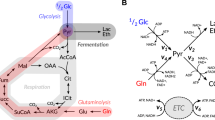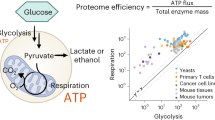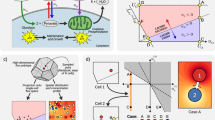Abstract
Aerobic glycolysis is a seemingly wasteful mode of ATP production that is seen both in rapidly proliferating mammalian cells and highly active contracting muscles, but whether there is a common origin for its presence in these widely different systems is unknown. To study this issue, here we develop a model of human central metabolism that incorporates a solvent capacity constraint of metabolic enzymes and mitochondria, accounting for their occupied volume densities, while assuming glucose and/or fatty acid utilization. The model demonstrates that activation of aerobic glycolysis is favored above a threshold metabolic rate in both rapidly proliferating cells and heavily contracting muscles, because it provides higher ATP yield per volume density than mitochondrial oxidative phosphorylation. In the case of muscle physiology, the model also predicts that before the lactate switch, fatty acid oxidation increases, reaches a maximum, and then decreases to zero with concomitant increase in glucose utilization, in agreement with the empirical evidence. These results are further corroborated by a larger scale model, including biosynthesis of major cell biomass components. The larger scale model also predicts that in proliferating cells the lactate switch is accompanied by activation of glutaminolysis, another distinctive feature of the Warburg effect. In conclusion, intracellular molecular crowding is a fundamental constraint for cell metabolism in both rapidly proliferating- and non-proliferating cells with high metabolic demand. Addition of this constraint to metabolic flux balance models can explain several observations of mammalian cell metabolism under steady state conditions.
Similar content being viewed by others
Article PDF
Author information
Authors and Affiliations
Corresponding author
Rights and permissions
About this article
Cite this article
Vazquez, A. Molecular crowding defines a common origin for the Warburg effect in proliferating cells and the lactate threshold in muscle physiology. Nat Prec (2011). https://doi.org/10.1038/npre.2011.5784.1
Received:
Accepted:
Published:
DOI: https://doi.org/10.1038/npre.2011.5784.1



